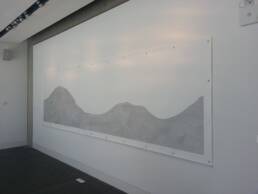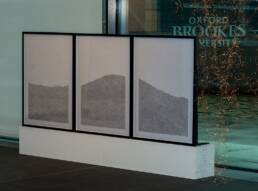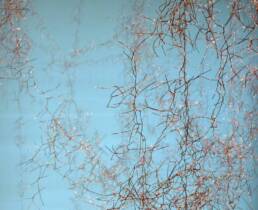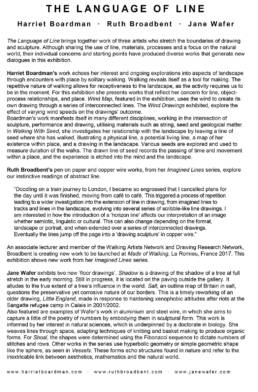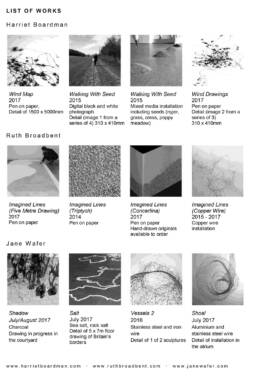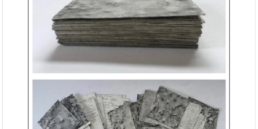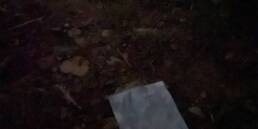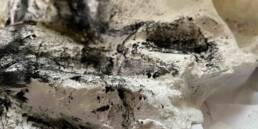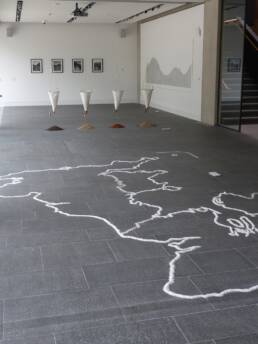
The Language of Line
Exhibition at Glass Tank, Oxford (2017)
THE LANGUAGE OF LINE
Harriet Boardman • Ruth Broadbent • Jane Wafer
The Language of Line brings together the work of three artists who stretch the boundaries of drawing and sculpture. Although sharing the use of line, materials, processes and a focus on the natural world, their individual concerns and starting points have produced diverse works that generate new dialogues in this exhibition.
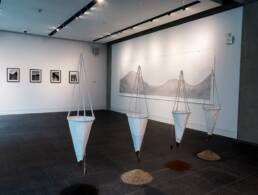
Harriet Boardman’s work echoes her interest and ongoing explorations into aspects of landscape through encounters with place by solitary walking. Walking reveals itself as a tool for making. The repetitive nature of walking allows for receptiveness to the landscape, as the activity requires us to be in the moment. For this exhibition she presents works that reflect her concern for line, object-process relationships and place. Wind Map, a piece featured in the exhibition, uses the wind to create its own drawing through a series of interconnected lines. The Wind Drawings exhibited, explore the effects of varying wind speeds on the drawings’ outcome.
Boardman’s work manifests itself in many different disciplines, working in the intersection of sculpture, performance and drawing, utilising materials such as string, seed and geological matter. In Walking with Seed, she investigates her relationship with the landscape by leaving a line of seed where she has walked, illustrating a physical line, a potential living line, a map of her existence in within place, and a drawing of the landscape. Various seeds are explored and used to measure the duration of the walks. The drawn line of seed records the passing of time and movement within a place, and the experience is etched into the mind and the landscape.
Ruth Broadbent’s pen on paper and copper wire works, from her Imagined Lines series, explore our instinctive readings of abstract line.
“Doodling on a train journey to London, I became so engrossed that I cancelled plans for the day until it was finished, moving from cafe to cafe. This triggered a process of repetition leading to a wider investigation into the extension of line in drawing, from imagined lines to tracks and lines in the landscape, evolving into several series of scribble-like drawings. I am interested in how the introduction of a ‘horizon’ line affects our interpretation of an image whether semiotic, linguistic or cultural. This can also change depending on the format, landscape or portrait, and when extended over a series of interconnected drawings. Eventually the lines jump off the page into a ‘drawing sculpture’ in copper wire.”
An associate lecturer and member of the Walking Artists Network and Drawing Research Network, Broadbent is creating a new work to be launched at Made of Walking, La Romieu, France 2017. This exhibition shows new work from her Imagined Lines series.
Jane Wafer exhibits two new ‘floor drawings’. Shadow, is a drawing of the shadow of a tree at full stretch in the early morning. Still in progress, it is located on the paving outside the gallery. It alludes to the true extent of a tree’s influence in the world. Salt, an outline map of Britain in salt, questions the preservative yet corrosive nature of our borders. This is a timely reworking of an older drawing, Little England, made in response to hardening xenophobic attitudes after riots at the Sangatte refugee camp in Calais in 2001/2002.
Also featured are examples of Wafer’s work in aluminium and steel wire, in which she aims to capture a little of the poetry of numbers by embodying them in sculptural form. This work is informed by her interest in natural sciences, which is underpinned by a doctorate in biology. She weaves lines through space, adapting techniques of knitting and basket making to produce organic forms. For Shoal, the shapes were determined using the Fibonacci sequence to dictate numbers of stitches and rows. Others works in the series use hyperbolic geometry or simple geometric shape like the sphere, as seen in Vessels. These forms echo structures found in nature and allude to the inextricable link between aesthetics, mathematics and the natural world.
www.harrietboardman.com • www.ruthbroadbent.com • www.janewafer.com
